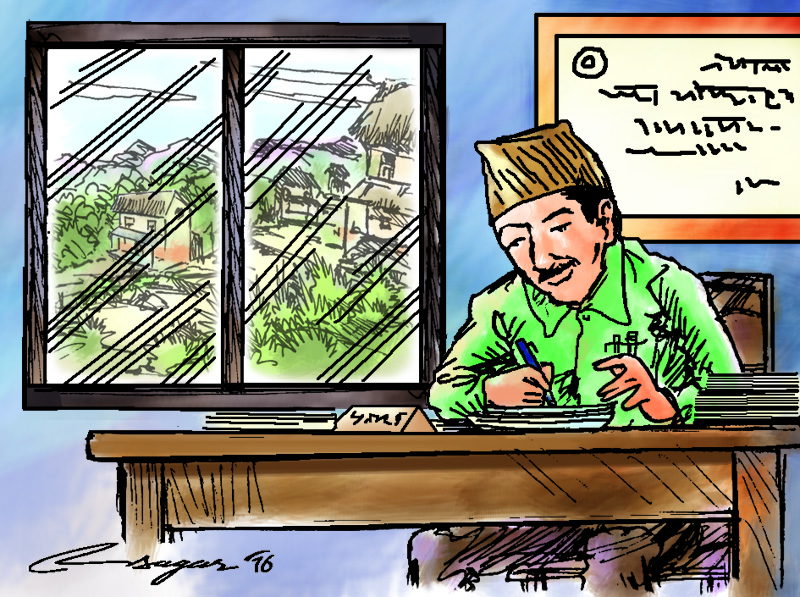Local level restructuring: Focus on service and participation
The ideal of the political parties is not only to see that public utility/services reach every individual but also to ensure his or her political participation. In the absence of wards and villages, it would be impossible to guarantee wider political participation
It is a constitutional compulsion to hold local level elections to elect the National Assembly (Upper House) as chairmen and vice-chairmen of Village Councils and Municipalities are the voters, and in the absence of the Upper House, Parliament will remain incomplete.
Interestingly, under transitional management of the new constitution, the three major parties promptly elected the new Prime minister, President, Vice-president, Speaker and Deputy speaker of the Legislature-Parliament (L-P).
Now the focus of the government had shifted to hold elections to local level units as per transitional provision (Art. 295), for which the previous government had formed a Local Level Restructuring Commission (LLRC) in March last. To hold elections the number and boundaries of the local units have to be fixed.
In this connection, the new Constitution, Art. 56 (4) provides for,” Under local level, there shall be Village Council (VC), Municipality and District Assembly.
The number of wards of the Village Council and Municipality shall be as per federal law.” Further, Art. 56 (5) provides for, ” For preserving social, cultural or economic development, special, reserved or autonomous regions can be established as per federal law.”
Contrary to the above provisions, Art. 295 (3) empowers the government to constitute a commission to determine the number and boundary of the local units envisaged in Art. 56 as per the criteria fixed by the government.
Significantly, in view of these contradictory provisions, the formation and functioning of LLRC seem controversial as well as challenging.
If the Commission delays recommendations, the election cannot be conducted on time.
The LLRC had proposed 565 village councils on the basis of number of persons as 15,000 in mountain region and 35,000 in Tarai region and 35,000 for municipality in mountain region and 75,000 for Tarai region in place of the existing 3,157 Village Development Committees (VDCs) and 217 municipalities.
In the meantime, the new government, which has replaced the Oli-led government, has asked the LLRC on September 27 to increase the number of VCs to 927, treating Ilakas (area of a cluster of three to four VDCs) as the main basis for fixing the number of VCs, as per agreement reached between the three major parties on September 26.
The government had again requested the LLRC on October 3 to hold Ilakas as ’one of the bases’ while fixing the number of local units. However, in consultation with the LLRC, the government has again mandated the LLRC on October 7 to have population and geography as the bases for splitting or merging the Ilakas, and, while proposing the special, autonomous or reserved regions, the entire municipality or VDC or a ward can also be taken into account.
Ironically, the frequent changes in the mandates prove lack of clarity behind the formation of the local units. There are two actors constitutionally responsible for forming the local level units -- the LLRC and the political parties.
The latter are constitutionally empowered to provide guidelines to the LLRC. The Commission has to follow the criteria fixed by the government for determining the number and boundary of the local units as per Art. 295 (3).
However, these two actors seem to be guided by two different considerations.
The LLRC seems to attach more importance to managing the local administration by curtailing the number of wards and the VDCs.
Previously, a ward was the lowest level unit of the VDC. By eliminating the ward and reducing the number of VDCs the LLRC has overlooked the importance of political participation of the people as the bigger the constituency of election, the less heard are the voices of the minorities and the marginalized communities due to their less representation.
It also defeats the main purpose of decentralization where state power is devolved not only to any village but also to the ward and every person and public services are to be delivered to the footsteps of the last individual.
Thus, the motive of the Commission does not seem to serve the people but only to govern them. Over and above, the Commission appears to be governed by the political consideration of reducing the number of local units in Tarai region where the majority of population reside.
Since chairpersons and vice-chairpersons will be the voters for presidential and vice-presidential elections, the reduced number of voters in Tarai will definitely affect the election.
On the contrary, the ideal of the political parties is not only to see that public utility/services reach every individual but also to ensure his or her political participation.
In the absence of wards and villages, it would be impossible to guarantee political participation of minorities, marginalized communities and the weaker sections of society. It will be a mockery of democracy.
The restructuring of local level as suggested by the LLRC is possible where a country is developed in communication and village settlement is under way or where the state is authoritarian.
Alternately, if the Commission approves the existing structures and suggests formation of special or reserved regions to meet the provisions of the constitution, election to local level seems possible without delay.
Instead of dismantling of the existing structures, slight adjustment will be needed, which can be done without wasting any time.






